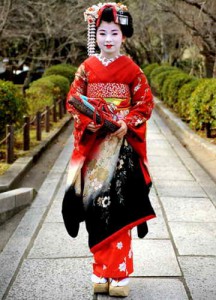 In connection with particular ethnos, patriotism is formed not only by means of traditions, language, coloring, but also by clothes. All these factors have considerable influence on mind of neighboring nations. Each nation has its own certain traditions, faith and symbolism and appropriate clothing symbolizing the history of this very nation. The purpose of clothing is not only to get warm but to bring us the unique charm and aesthetic appearance.
In connection with particular ethnos, patriotism is formed not only by means of traditions, language, coloring, but also by clothes. All these factors have considerable influence on mind of neighboring nations. Each nation has its own certain traditions, faith and symbolism and appropriate clothing symbolizing the history of this very nation. The purpose of clothing is not only to get warm but to bring us the unique charm and aesthetic appearance.
Traditionally the most important ethnic identification of national clothing is supposed to be the color of material the clothing is made of. Both color and ornament were the ways for the national ideology and taste expression. On the basis of the colour of clothing it was possible to define its nature and purpose: ordinary, festive or ritual. It seemed that colour had the unique language for understanding such notions as welfare, strength, fertility and expressing such feelings as sadness, happiness, love. The colour also was in harmony with nature, bringing such perceptions as white light, black night and red sun.
National suit is immediate constituent of national awareness and the part of national soul. Its task is defined in representation of artistic image and personification of esthetic ideal of the nation. Since the suit has being created and completed during the centuries, it now embodies the national history and values. Nowadays national clothing is the way of patriotic feelings expression. The clothing reflects the nation’s struggle for sovereignty and rebirth of national culture. Each nation can view in national clothing the history of creation of the nation.
Supplementing the fancy clothing with the elements of national dress to is reflects the patriotic feelings, battle for revival of national suit and is a valuable contribution to the national awareness. The symbolism of national suit is one of the most important national traditions’ components. Such information brings not only evolution of the suit, but also stimulates the viability of nation. The ethnic symbolism of suit expresses the national affiliation of a human being. Generally speaking each nation estimates its national clothing as the most beautiful.
Traditional Ukrainian national dress complied with physical and different social needs. Notwithstanding the fact that national dress is a material product, but its maximal simplicity makes possible to apply the functions of spiritual culture. The diversity of symbols and their combinations inevitably connected with function of the dress. The role of national dress functions significantly increased at that very moment when it was changed by the nationals at appropriate events from ordinary to festive or ritual. Usually, aesthetic appearance of clothing was more important than its practical function. Therefore, the practical function in festive dress played minor role, while the ritual ones completely negated this functionality. It should be noted that traditional Ukrainian men’s wear is similar to East-Slavonic, Russian, Belarusian.
Principally the basis of men’s wear is a shirt sewn from hempen or linen material. The Ukrainian shirt differs from the others by section from the front, known as bosom, decorated by embroidery. The history of Ukrainian embroidery originates from the deep centuries. According to the archeological excavations and from the chronicles we revealed that embroidery had already appeared as branch of art since long ago. According to Herodotus the Scythian dress had been decorated by embroidery. In X-th century one Arabian traveler distinguished that ‘Rusichy people’ had retained a tradition to embroider clothing. The seventies signaled revival of Ukrainian culture.
It has become fashionable to complement urban clothing by nation dress. A plenty of citizens were attracted by brightly coloured and originality. At the end of the XX-th century there were meetings, such as can observe nowadays, and Ukraine independence fighters accoutered the national dresses. Embroidery shirts, badges and blue-and-yellow stripes have become symbols of the independence of Ukraine. At that time, it has become updated to dress children in stylized national clothing. The national impetus has become the advanced theme for collections of Ukrainian designers.
Near the year 1880 in Norway, the theme of the Norwegian past became in society popular because of the movement for independence intensification; in other word the aspirations of the nation to express its independence increased. Artisans and ethnographers elaborated a vast majority variants of national suits inspired by ancient clothing of different Norwegian regions. Nowadays Norwegians wear their traditional clothes that is the result of remodeling on occasion of festive days.
In Finland the enthusiasm for national clothing also refers to national liberation movement at the end of XIX-th century. In Poland the national clothing revival is connected with the national liberation movement. The consultation on the issue how to sew national suits was hold in Krakow Museum of Ethnography. In the early years of the XX-th century people actively started to restore the Austrian national clothing.
There were not only consultations, but also many ateliers and even magazines presented the samples of traditional clothing for the enthusiasts of this style. Magazines and ateliers offered Austrians not only the samples for sewing the clothes for wearing on the weekends but also promoted the modern fashion on basis of traditions. There were opulent boutiques in the capital of Austria where it was possible to buy the elegant national style clothing.
It is possible to exemplify not only Europe but also the countries of Asia and America. However the common feature for all the countries is that national clothing initiated there the boost of national awareness and raise of the value and prestige. The national clothing is a symbol of patriotic feelings, national perfection and unity of the nation!
